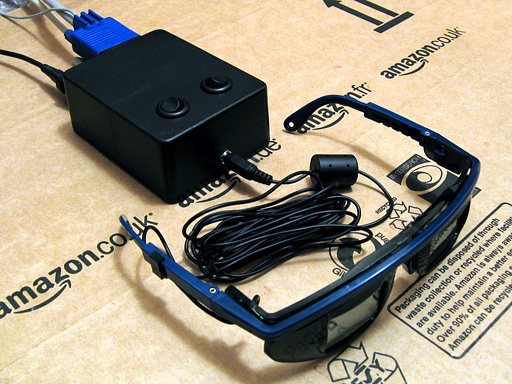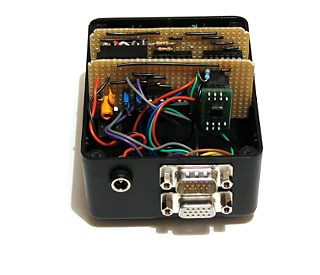LCD Shutter Glasses Adaptor

This is a cheap and relatively easy to build device that allows you to use cheap LCD shutter glasses to view stereoscopic 3D images on your CRT PC monitor. It sits beween the PC and the monitor, and works with alternate frame and alternate row stereoscopic image formats. An integrated line blanker can be used to simulate an interlaced video mode from a progressive one, which neatly avoids the inability to use interlaced video modes at high refresh rates with most modern video card drivers.
You can find different designs for similar adaptors at the Homebrew Shutterglasses Controllers page on the stereo3d.com website – I found the parts difficult to find for most of their designs, and wanted something a bit simpler, so designed this one!
Building the adaptor
You can download a schematic of the adaptor (PDF). I have written up a building a VGA line blanker and 3D glasses driver in the journal section of this site, and a rough overview of the operation of the circuit can be found in the journal entry describing the prototype VGA line-blanker.
Click and drag on the above image to see a 360° view of the insides of the VGA line blanker.
Using the adaptor
The VGA input on the adaptor should be connected to the video card on the PC and the VGA output on the adaptor should be connected to the monitor. An external power supply is required whether you are using the adaptor for 3D or not – without it, the the PC will be able to recognise the monitor but the screen will appear blank.
Cheap controllerless LCD shutter glasses can be plugged into the 3.5mm stereo jack socket on the adaptor.
Closing the LINE_BLANK_DISABLE switch disables the link blanker. Keep this switch closed if you are using alternate frame 3D or are using alternate row 3D and have set the video card to use interlaced scanning.
Opening the LINE_BLANK_DISABLE switch enables the link blanker. Use this if you are dealing with the alternate row 3D format and have set the video card to use progressive scanning (most video card drivers will only let you use this mode by default).
You will need to check that the left and right eyes are receiving the correct images. I find the easiest way to do this is to observe an object in the foreground. Closing your left eye should make the object appear to move left relative to the background, and closing your right eye should make it appear to move right relative to the background. If the left and right eye views are reversed, adjust the SWITCH_EYE switch (open it if it was previously closed; close it if it was previously opened).
The device should work with both positive and negative sync pulses, but changing these settings may cause the left and right eye views to be reversed. Use the SWITCH_EYE switch to restore the correct settings.
See also
- stereo3d.com – Lots of useful information about stereoscopic 3D.
- YouTube – Hosts some stereoscopic 3D videos; search for the special yt3d:enable=true tag.
- Stereo Quake – Play Quake and Quake II in stereoscopic 3D.
- iZ3D – Provides a driver that adds several stereoscopic rendering modes to existing games (available as a time-limited trial).
